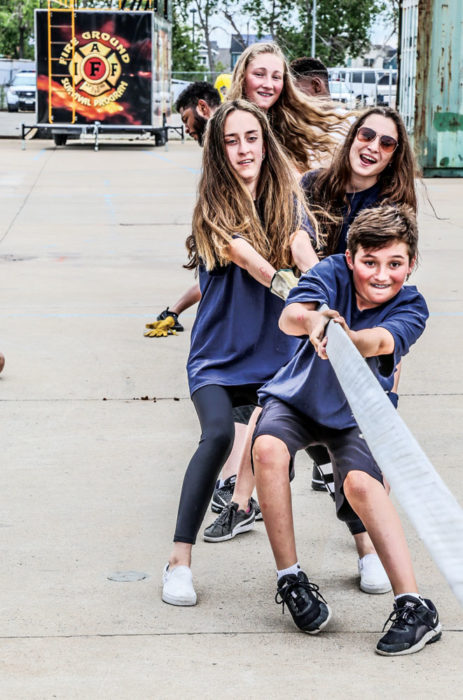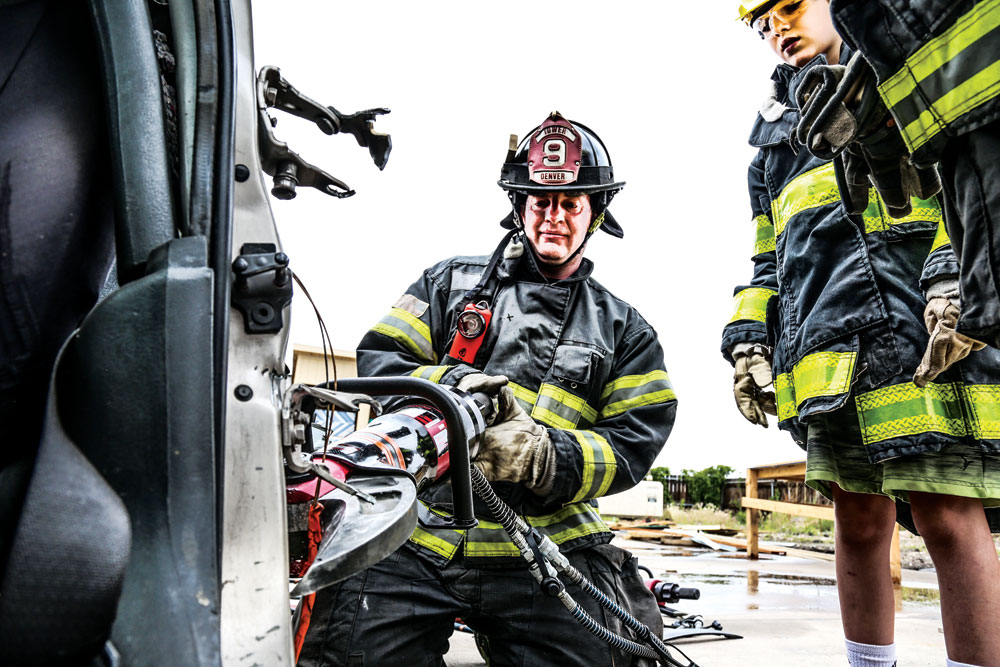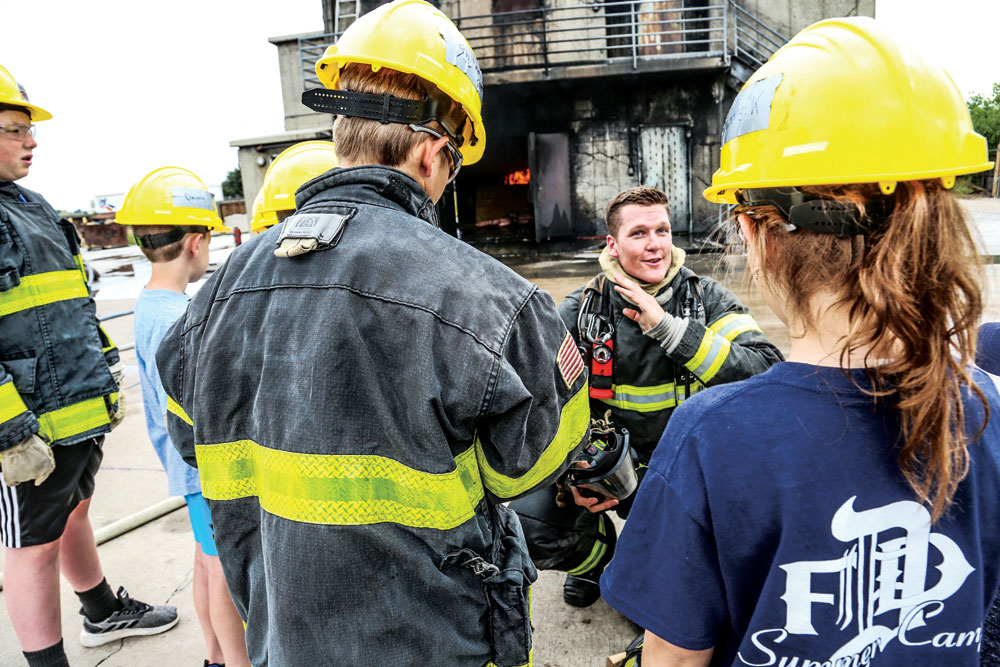
Camp participants have a tug-of-war with a fire hose.

Firefighter Sean Nielsen shows Miah Caro, 12, of Aurora, how to operate the nozzle. “I love getting to learn how to put out fires and stuff,” says Caro, who hopes to become a firefighter.
Contrary to what we all learned from that one Friends episode, having a friend pee on your jellyfish sting will not alleviate your pain. “No, that won’t do a thing,” says Heather Edwards, a paramedic and educator with Denver Health’s Paramedic Division. Edwards recommends vinegar or really hot water to denature the poison after a jellyfish sting. She is one of several Denver Health educators who combat myths like this while teaching kids real first aid at the Denver Fire Department’s annual firefighter camp at the Rocky Mountain Fire Academy near Northfield.

Technician Joe Huth uses the “Jaws of Life” to cut into a crashed car.
Denver Fire Department Captain Greg Pixley launched the camp four years ago as a way of exposing girls in particular to firefighting and other first responder career fields. Each summer, about 75 youth put out fires, cut up a car wreck, use an ax, climb ladders, and learn valuable CPR and first aid skills in this three-day camp. But beyond these hands-on skills, they see role models who look like them in a career they perhaps hadn’t considered, and learn leadership and teamwork.

Nielsen talks to kids about safety while a fire burns in the background. Kids shared their favorite aspects of the camp, including: “climbing stairs, the jaws of life, the food, the bucket race, and being dry.”

Lt. Robbie Turner joins students in a tug of war using fire hoses.
It is teamwork that allows these children to manage and maneuver the cumbersome, heavy fire hose and direct an erupting blast of water at a fire. The charred building looks like a movie set, but these are not actors. They are kids aged about 9-15 from around the Denver Metro area; one camp is co-ed and the other is girls-only. Funding from the City of Denver’s Office of Children’s Affairs, the DFD Foundation, The Hartford, and other sources ensures that the camp is free, a bonus for parents.
“I really want to empower girls and give them the knowledge that no matter what struggles they face in life, they can do anything,” Pixley says. He hopes the camp plants a seed for some of these participants, so that in the future, more young women will choose to become first responders. Though Pixley’s vision was to give girls an opportunity to explore firefighting, he also offers a co-ed camp to allow boys to participate. The curriculum is the same in each camp, but he believes the girls-only space may empower some girls more. Both camps challenge kids to overcome their fears as they navigate an obstacle course or climb a truck’s fire ladder to enter a fourth-story doorway just as real firefighters do.
Edwards reflects on her own professional path: “I was a sophomore at Columbine High School during the 1999 shooting, and after completing high school, my first semester of college I took a first responder course. It was an elective to fill my schedule, but one that I picked with the thought that if I am ever in a situation like Columbine again, I didn’t want to feel so helpless. Everything about the course just clicked with me and I knew that I wanted to continue my education and become a paramedic.”
“Growing up, when you don’t see yourself represented in that demographic you think it’s not for you; but this is literally for everybody….I love the diversity…not all of our patients are white or men…it’s important to have diversity in our profession,” says Edwards.
Edwards and other Denver Health paramedics and EMTs take the lead on one of the camp days to teach adult and infant CPR, first aid, and AED (automatic external defibrillator) use. Each child who successfully completes these individual components receives their certification in CPR, AED, and First Aid, a point of pride and a boon to their babysitting resumes. “We teach kids how to administer medicines like inhalers and epi pens, how to deal with heat exhaustion and hypothermia, and what to do if someone is choking,” Edwards says.
Edwards would love to see more community groups and schools take advantage of the trainings that Denver Health offers. “In my ideal world, all high school sophomores and seniors would receive training, which certifies them for two years.” She is motivated by statistics which show that “for every minute without CPR, a person’s chance of survival decreases by 7-10%.” The minutes one might have to wait for first responders to arrive are critical. “With bystander assistance, a person’s chances of survival increase by over 40%,” says Edwards.
Pixley clearly loves what he does, and he sees the camp as a recruiting tool. “If I can get a young lady or young man and educate them at this point of their lives to understand that firefighting is a righteous career and has the opportunity for people to really enjoy their work, I can hopefully plant a seed.”
Denver Health offers CPR and other trainings on-site and at their downtown education center, and will schedule private sessions for groups of 10 or more. For more information see: https://denverhealthparamedics.org/community-education.


0 Comments